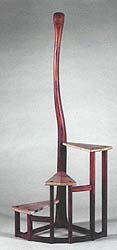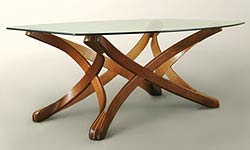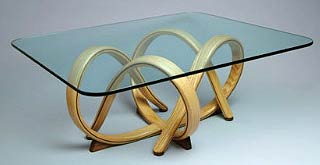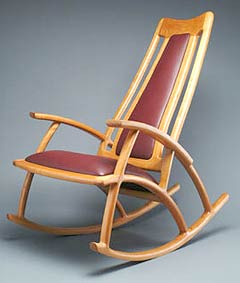
Larry and Nancy Buechley have the sort of partnership that most of us think exists only in fiction. They share their lives, work, recreation, and design ideas. Even their sentences dovetail together so that a conversation with them is as seamless as speaking to one person.
Together, they create constantly evolving pieces with impossibly flowing lines. Their rocking chairs sport graceful bentwood limbs, their side chairs and occasional pieces boast sweeping curves and unlikely angles, and their clear-topped tables are nothing less than sculpture under glass, with bases reminiscent of gracefully woven origami paper strips.

A partnership like that does not happen overnight, and this one was a long time in development. Though they were both born in Pennsylvania, each of their families eventually moved to northern Indiana. They met in high school while designing and building sets for the theater department.
They studied art in college, Larry focusing on sculpture and Nancy on painting, then moved to New Mexico in the early seventies. After trying various ways of making a living in art, including selling bowls and cutting boards at craft fairs, they discovered that what folks really wanted to buy was their furniture. In 1975, they got married and started their woodworking business in the remote New Mexico town of Chamisal. There they created what is for them the ideal life.

“We wanted to live in a remote place, and raise our children so we could be home with them,” said Nancy, “and we wanted to have artistic expression in our lives. It was a struggle for a long time.” Along the way, they raised three children, developed their unusual designs, and these days also find time to be instructors in woodworking, skiing, and, strangely enough, mathematics. The furniture studio, though, is their primary job activity, and their beautiful bentwood forms lend a distinctive character to their work.
“Much of our work has bent laminations in order to get the curves we want,” Nancy explained. “Coming from a fine arts background, it is the design that turns us on, but that doesn’t mean that we let the technical end lapse. We also really focus on the craftsmanship.”
“Because we came from this from the art end, rather than the technical school end,” continued Larry, “we are more interested in form, balance, positive and negative space, and so on. We had to learn about the functional and construction issues. Much of that came from reading books and magazines.” Added Nancy, “and trial and error.”
“We didn’t know wood when we started out,” they continued, often interjecting for one another and effortlessly sharing the conversation. “We had to teach ourselves about wood movement, joinery, ergonomics, and practicality for good usage. We went to books like ‘The Encyclopedia of Furniture Making,’ [by Ernest Joyce] and to early woodworking magazines, in large part because of our remote location. We live in the mountains of northern New Mexico. We’re a mile from our nearest neighbors.”
“We are self-taught; we discover what we need to learn and figure it out. Because we didn’t go to traditional woodworking school, we are not constrained by traditional joinery.” As a consequence, little of their work shows squares or right angle joinery. “We enjoy challenging designs and have our own esthetic that has a definable style.” This is particularly evident in their glass top tables and their chairs.

“When designing, we just sit down and throw around ideas. We can both draw very well, and see in three dimensions well. We come up with a lot of little sketches until we see something we like. Sometimes we have to build a small model, but we usually build it straight from a sketch. We like smooth simple lines and curves flowing into one another without a lot of detail or business to distract from it. There’s complexity in the form itself, in the curves and twists; the laminations are not just simple bends.”
A variety of woods show up in their pieces, with natural colors and textures creating visual variety. “We used to employ more exotics, because we like the ability to have high color contrast, but these days we use mostly American hardwoods, in part for philosophical reasons.”
Once the designing and building is done, there is the business end to contend with, and selling furniture that far from big cities is not easy. “We got lucky early in our career. There was a gallery at that time in Santa Fe that showed our furniture for over two decades. Living remotely, the big issue is marketing, and that gave us access and visibility. These days, we have outlets that sell our work, a web site, and more history to fall back on. We also have a client base that returns frequently. About half our work is commission, but we prefer building on spec. We’ll make a design to fit a space or use, but we don’t make other people’s designs.”

“We hope our work speaks for itself. We felt that if we work hard enough, and put our hearts and souls into it, we’d eventually be discovered. At the moment, we feel we are somewhat under-discovered. We’re not good about promoting our own work.”
Among their designs, their own favorites include the ‘En Pointe,’ ‘Nova’ and ‘Woven Wood’ tables, and the ‘Wishbone’ rockers and ‘Alpha’ chairs. “The Wishbone is still a work in progress, and we don’t feel it is quite there yet” they insisted. To my eye, it certainly appears to have arrived, along with the rest of their designs, and with work like that, I suspect further discovery will not be far behind.







